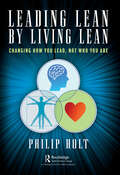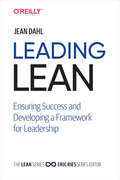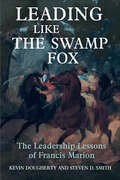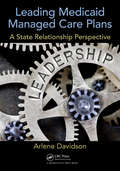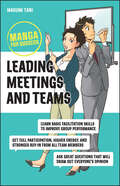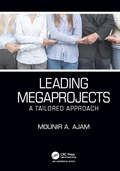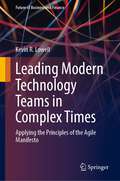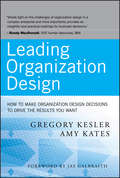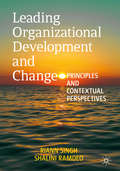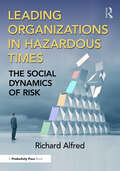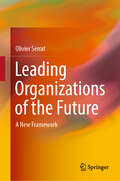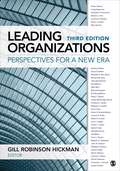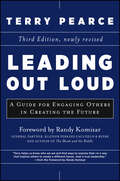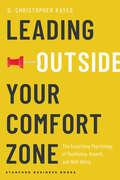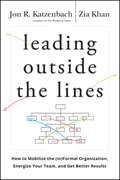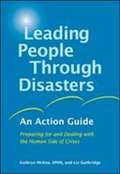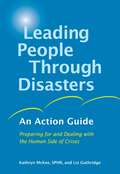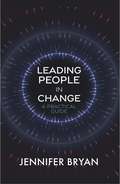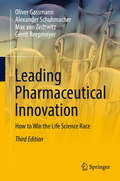- Table View
- List View
Leading Lean by Living Lean: Changing How You Lead, Not Who You Are
by Philip HoltIn Leading Lean by Living Lean, Philip Holt details and explains what is probably the most important part of becoming a Lean Leader -- living and practicing what you preach. To do this you must believe in what you’re doing, understand what it means and what you need to do, and do it every day. The author, through his engineering background, has fully embraced the Plan-Do-Check-Act (PDCA) model of Deming / Shewhart but has adapted David Bovis’ Believe-Think-Feel-Act (BTFA) model to understand why logic and facts are very often not the principal players in the game of change. In this book, Holt author describes how you can take both the PDCA and BTFA models into account and has sectioned the book into three prime parts: 1. Head -- How you learn and understand the Lean principles and their application. 2. Hands -- How you practice Lean Leadership daily. 3. Heart -- How you internalize and believe in Lean Leadership. Through this book, you, the Lean practitioner, whether aspiring or experienced, will have everything that you need to “lead it,” “do it,” and “live it.” The nature of this book is more “why to” than “how to” – the author knows that he cannot tell you how to lead, do, or live Lean; he can only explain why it is so important and share his knowledge, experiences, failures, and successes. This book isn’t so much a self-help book as a self-reflection book and it can point you in the proper direction, but… the book won’t change you; only you can change you! Essentially, with this book, the author wants those who think of Lean as a toolkit, who believe that Lean can be project managed, or who argue about Lean versus Six Sigma and misunderstand the fundamental depth of impact that true Lean Leadership has on an organization to be disabused of any or all of those notions. This book is aimed at those leaders who seek to experience the full transformative effects of Lean in their organizations and want to practice it at the principle level of deployment. Holt's aim is to help business leaders enhance who they are by changing what they do and the way that they do it
Leading Lean by Living Lean: Changing How You Lead, Not Who You Are
by Philip HoltIn Leading Lean by Living Lean, Philip Holt details and explains what is probably the most important part of becoming a Lean Leader -- living and practicing what you preach. To do this you must believe in what you’re doing, understand what it means and what you need to do, and do it every day. The author, through his engineering background, has fully embraced the Plan-Do-Check-Act (PDCA) model of Deming / Shewhart but has adapted David Bovis’ Believe-Think-Feel-Act (BTFA) model to understand why logic and facts are very often not the principal players in the game of change. In this book, Holt author describes how you can take both the PDCA and BTFA models into account and has sectioned the book into three prime parts: 1. Head -- How you learn and understand the Lean principles and their application. 2. Hands -- How you practice Lean Leadership daily. 3. Heart -- How you internalize and believe in Lean Leadership. Through this book, you, the Lean practitioner, whether aspiring or experienced, will have everything that you need to “lead it,” “do it,” and “live it.” The nature of this book is more “why to” than “how to” – the author knows that he cannot tell you how to lead, do, or live Lean; he can only explain why it is so important and share his knowledge, experiences, failures, and successes. This book isn’t so much a self-help book as a self-reflection book and it can point you in the proper direction, but… the book won’t change you; only you can change you! Essentially, with this book, the author wants those who think of Lean as a toolkit, who believe that Lean can be project managed, or who argue about Lean versus Six Sigma and misunderstand the fundamental depth of impact that true Lean Leadership has on an organization to be disabused of any or all of those notions. This book is aimed at those leaders who seek to experience the full transformative effects of Lean in their organizations and want to practice it at the principle level of deployment. Holt's aim is to help business leaders enhance who they are by changing what they do and the way that they do it
Leading Lean: Ensuring Success and Developing a Framework for Leadership
by Jean DahlCompanies from startups to corporate giants face massive amounts of disruption today. Now more than ever, organizations need nimble and responsive leaders who know how to exploit the opportunities that change brings. In this insightful book, Jean Dahl, a senior executive and expert in the Lean mindset and its methods, demonstrates why you need to embrace Modern Lean principles and thinking to redefine leadership in this age of digital disruption in order to continuously evolve the Lean enterprise.Drawing on nearly three decades of corporate and consulting experience, Ms. Dahl lays out a new holistic framework for developing Modern Lean leaders. Through personal experiences and compellingreal-world case studies, she explains specific steps necessary for you and your company to proactively understand and respond to change.Understand the leadership challenges Lean leaders face in our 21st century global economyExplore the six dimensions of the Modern Lean Framework™Learn and apply the nine steps necessary to become a Lean leaderUse Modern Lean methods to build a culture of continuous learning that can be sustained and maintained within your organizationSeize competitive advantage by embracing Modern Lean to tbuild an enterprise that understands how to respond to disruption
Leading Like the Swamp Fox: The Leadership Lessons of Francis Marion
by Steven D. Smith Kevin DoughertyA riveting and applicable study of how Francis Marion delivered the leadership and strategy to defeat the British in the South Carolina lowcountry campaigns.Francis Marion is certainly the stuff of which legends are made. His nickname “The Swamp Fox,” bestowed upon him by one of his fiercest enemies, captures his wily approach to battle. The embellishment of his exploits in Parson Weems’ early biography make separation of fact from fiction difficult, but certainly represents the awe, loyalty, and attraction he produced in those around him. His legacy is enshrined in the fact that more places in the United States have been named after him than any other soldier of the American Revolution, with the sole exception of George Washington. Even today’s U.S. Army Rangers include Marion as one of their formative heroes. Surely much about leadership can be learned from such an intriguing personality. Leading like the Swamp Fox: The Leadership Lessons of Francis Marion unlocks those lessons. Divided into three parts, the book first presents the historical background and context necessary to appreciate Marion’s situation. The main body of the book then examines Marion’s leadership across eight categories, with a number of vignettes demonstrating Marion’s competency. The summary then captures some conclusions about how leadership impacted the American Revolution in the South Carolina Lowcountry. An appendix provides some information about how the reader might explore those physical reminders of Marion and his exploits that exist today. Readers interested in history or leadership, or both, will all find something for them in Leading like the Swamp Fox.
Leading Matters: Lessons from My Journey
by Walter Isaacson John L. HennessyIn Leading Matters, current Chairman of Alphabet (Google's parent company), former President of Stanford University, and "Godfather of Silicon Valley," John L. Hennessy shares the core elements of leadership that helped him become a successful tech entrepreneur, esteemed academic, and venerated administrator. Hennessy's approach to leadership is laser-focused on the journey rather than the destination. Each chapter in Leading Matters looks at valuable elements that have shaped Hennessy's career in practice and philosophy. He discusses the pivotal role that humility, authenticity and trust, service, empathy, courage, collaboration, innovation, intellectual curiosity, storytelling, and legacy have all played in his prolific, interdisciplinary career. Hennessy takes these elements and applies them to instructive stories, such as his encounters with other Silicon Valley leaders including Jim Clark, founder of Netscape; Condoleezza Rice, former U.S. Secretary of State and Stanford provost; John Arrillaga, one of the most successful Silicon Valley commercial real estate developers; and Phil Knight, founder of Nike and philanthropist with whom Hennessy cofounded Knight-Hennessy Scholars at Stanford University. Across government, education, commerce, and non-profits, the need for effective leadership could not be more pressing. This book is essential reading for those tasked with leading any complex enterprise in the academic, not-for-profit, or for-profit sector.
Leading Medicaid Managed Care Plans: A State Relationship Perspective
by Arlene DavidsonLeading Medicaid Managed Care Plans examines leadership actions necessary to successfully operate a Medicaid managed care plan with emphasis on the relationship with the state Medicaid agency the health plan is contracted with. With appropriate operational and governance oversight, and with solid mutually respectful relationships with the state agency, Medicaid health plans are more likely to sustain success and prosperity for the long term. The approach of Leading Medicaid Managed Care Plans builds on key infrastructure elements that need to be in place when contracting with a state agency, and for overall success of the organization. It takes a pragmatic and methodical approach, interspersed with real-life examples of what to do for success and what actions to avoid that frequently lead to failure. This approach is different from most managed care books (Medicaid or otherwise) as those mostly focus on the process of the business (such as details around claims payment, or provider contracting) and ignore the role of the state Medicaid agency and its importance in retaining the contractual relationship. This book differs also on its emphasis on organizational foundational elements and strategic leadership skills necessary to sustain success. The author has years of experience in turning around failing Medicaid managed care plans and observing what they all had in common that contributed to those failures. One common feature was the deterioration of the relationship with the state Medicaid agency they were contracted with, and how close they all came to losing their multi-million dollar businesses. The purpose of this book is to educate and inspire managed care executives and senior leaders who operate Medicaid health plans and to help them understand what elements are needed for successful health plans and a sustainable relationship with the people directing the state Medicaid agency.
Leading Meetings and Teams: Manga for Success (Manga for Success)
by Masumi TaniLEARN TO FACILITATE PRODUCTIVE MEETINGS AND BUILD HIGH-PERFORMING TEAMS WITH MANGA FOR SUCCESS! Shigeo, an employee of a building material manufacturing company, is sent to a regional office to improve sales. Along the way, he encounters challenges engaging with the local team but, with advice from a helpful facilitation specialist, Mayumi, he eventually learns to build the skills of his colleagues and cobble together a high-performing team. You’ll also learn about: How to run an effective business meeting How to productively use a variety of meeting tools Facilitating fruitful brainstorming sessions Using effective communication to lead your team to success Leading Meetings and Teams is a practical and hands-on book that will earn a place on the bookshelves of managers, executives, and early-career professionals everywhere. Find out why the Manga For Success series—now available in English for the first time—is so popular in Japan, Korea, and beyond.
Leading Megaprojects: A Tailored Approach
by Mounir A. AjamThe performance of megaprojects is questionable, and a large percentage of them fail in one dimension or another. The challenges that contribute to these failures are known. Then why do these projects still fail at a high rate? Leading Megaprojects: A Tailored Approach examines the challenges facing megaprojects and, more importantly, successes in delivering megaprojects. To close the performance gaps in megaproject deliveries, the book presents a customizable model that professionals and organizations can use to increase the chance of successful project delivery. To illustrate the model, it uses examples and case studies, primarily from capital projects, with engineering and construction components. The book also explains how the approach can be applied to all projects, regardless of industry or domain. The book emphasizes the role of leadership because it takes the point of view that megaprojects cannot be successful without great leadership due to their massive size, complexity, number of parties and stakeholders involved, and cost, among other vital factors. Leaders can define the path for a megaproject to guide seasoned managers and project managers to successful closure. The tailored approach is based on a stage-gate project life cycle model, which covers projects from concept to success. However, it is not limited to a purist form of traditional project management. It is a tailored methodological approach, with an emphasis on leading the work, end-to-end, at the project level, along with the management of every stage of the project. Also, it presents the integration of the business, product delivery, and operations management into a cohesive approach. The book concludes with an in-depth simulation showing how the model is can be tailored to deliver a megaproject successfully.
Leading Modern Technology Teams in Complex Times: Applying the Principles of the Agile Manifesto (Future of Business and Finance)
by Kevin R. LowellThe practices of agile software development and DevSecOps (Development integrated with Security integrated with Operations) differ from traditional linear systems of working. The people doing this work – who they are and what they expect – and the way the work gets done in today’s tech industry demand a leadership practice specific to this way of working. This book explores leadership practice in today’s technology industry using the twelve principles of the Agile Manifesto as a framework. Each of the twelve principles includes a section of key takeaways to help the reader apply the principle in practice. It extends traditional notions of leadership, specifically Complexity Leadership Theory (CLT), to one that is post-heroic, acknowledging the processual, conjunctive and generative nature of leadership relationships. Leader-follower dynamics are complex—they include power dynamics, conflict, ambiguity, and paradox—and technology organizations are complex. This book challenges the suitability of some aspects of complexity theory and offers practices that are more suitable for leading today’s technology organizations.
Leading Naturally
by Michael AlznauerThis book emphasizes that leadership is a task, one that has left evolutionary - and thereby enduring - traces in us. From this perspective the author develops the key elements of successful leadership. The reader is taken on an exciting journey through time and is granted a clear overview of the topic. Clear recommendations are given for application into practice, leadership diagnostics and development. The book gives numerous examples and is a valuable basis to support everyday hands-on leadership. ,,Without question a fascinating reading. Alznauer provides an unusual approach, which promotes exciting ideas on the topic of leadership. Content: Excellent. " (Book of the week Hamburger Abendblatt) ,,The book allows unusual approaches to the topic of leadership. It is an exciting reading both for leaders and their staff. " (Controller News) ,,All in all Alznauer provides an interesting contribution to demystify the notion of leadership. "(Swiss magazine Cash) ,,The book provides an unusual amount of suggestions and a valuable basis for constructive leadership work. " (Niedersächsische Rundschau) ,,Michael Alznauer turns the core of successful leadership upside down. His theories could trigger a revolution in the executive suites. " (Magazine Nobilis).
Leading Organization Design
by Gregory Kesler Amy KatesPraise for Leading Organization Design"Designing organizations for performance can be a daunting task. Kesler and Kates have done an admirable job distilling the inherent complexity of the design process into manageable parts that can yield tangible results. Leading Organization Design provides an essential hands-on roadmap for any business leader who wants to master this topic." -Robert Simons, Charles M. Williams Professor of Business Administration, Harvard Business School"Kesler and Kates have encapsulated their wealth of knowledge and practical experience into an updated model on organizational design that will become a new primer on the subject." -Neville Isdell, retired chairman and CEO, The Coca-Cola Company"In today's world of global business, organizational design is a critical piece of long-term success. Kesler and Kates have captured multiple approaches to optimize global opportunities, while highlighting some of the keys to managing through organizational transition. A great read for today's global business leaders." -Charles Denson, president, Nike Brand"Leading Organization Design has some unique features that make it valuable. It is one of the few and certainly only recent books to take us through an explicit process to design modern organizations. This is accomplished with the five-milestone process. The process is not a simple cookbook. Indeed, the authors have achieved a balance between process and content. In so doing, Kesler and Kates show us what to do as well as how to do it."-Jay Galbraith, from the Foreword"Sheds light on the challenges of organization design in a complex enterprise and more importantly provides aninsightful and practical roadmap for business decisions."-Randy MacDonald, SVP, human resources, IBM
Leading Organizational Development and Change: Principles and Contextual Perspectives
by Riann Singh Shalini RamdeoThis textbook covers the fundamentals of organizational development and change (ODC) theory while offering a comprehensive, structured, and systematic approach to guide change management strategies at the organization level. It provides an in-depth understanding of and the tools necessary for designing, diagnosing, implementing and evaluating organizational change interventions. Students will be exposed to case studies in ODC from selected international and Caribbean/Latin American organizations, demonstrating ODC in practice across a broad geographical context. This textbook, the first to offer a macro-level perspective of ODC, provides students with the tools needed to be successful in implementing change into today's organizations.
Leading Organizational Transformation: Embracing Liberation, Vitality, and Expression to Build a Success-Capable Organization (Palgrave Executive Essentials)
by Alejandro ReyesThis book is a comprehensive guide to navigating the complexities of organizational transformation in the post-pandemic era for CEOs, CHROs, and their teams. This is a rigorous analysis and in-depth framework of how to transform organizations by partnering and reimagining the role of HR and talent from a task-doer role into a co-creative humanistic partnership to transform organizations and drive long-term success. Executive and organizational transformation expert Alejandro Reyes equips readers to master organizational transformation through the embrace of three essential mindsets—liberation, vitality, and expression. Drawing on extensive industry experience, Reyes offers actionable strategies to align leadership aspirations with capabilities, fostering an engaging, inclusive, and high-performing workplace. By adopting the mindsets of liberation, vitality, and expression, leaders can ensure their organizations are equipped with the cultural and organizational infrastructure to meet new challenges and achieve sustainable success. The book is a guide for CEOs, CHROs, their teams, and other leaders to bridge the gap between their strategic aspirations and the practical implementation needed to realize their vision. Offering both high-level principles and practical guidance based on the author&’s decades of experience implementing these principles, this book is sure to help leaders make their vision into reality.
Leading Organizations in Hazardous Times: The Social Dynamics of Risk
by Richard AlfredDoes your organization have the capacity to respond to risk it has not anticipated or prepared for? Is its approach to risk explicit and understood by employees? Does it have a robust risk culture? Do employees take responsibility for managing risk? If your response to these questions is guarded or uncertain, this book will have value for you and your organization.Organizations and leaders in a widening risk environment face four realities which challenge their ability to manage risk: (1) the two-dimensional nature of risk—risk itself and behavior in response to risk, (2) the diversity of attitudes and behavior in relationship to risk, (3) the influence on behavior of cognitive, psychological and contextual factors that are part of social dynamics and (4) the compounding effect of social dynamics that make risk difficult to manage. These realities add up to a conundrum: The challenge for organizations and leaders lies not in risk itself but in social dynamics that shape behavior in response to risk.Whether triggered by an internal problem or external event, risk management failures often result from a lack of understanding of causative factors and behavior in response to risk. Effective leaders make risk a core part of their agenda. They put people at the center of strategy and face challenges head-on that impact their organizations’ ability to manage risk. Among the challenges are:◾ the toll on organizational resources of a growing array of risk factors◾ risk "blind spots" in the organization warranting attention◾ cultural weaknesses and vulnerabilities elevating exposure to risk◾ employee disengagement from risk and responsibility for managing it,◾ variation in attitudes and behavior that make risk difficult to detect and mitigate,◾ turning risk into advantage by envisioning it as an opportunity or strength in contrast to a threat or weakness.Leading Organizations in Hazardous Times: The Social Dynamics of Risk builds capability in risk management by enhancing leader understanding of risk behavior and factors contributing to risk culture. It encourages leaders to invest in continuous learning to navigate asymmetries of attitude and behavior, managing, and leadership style that underlie organizational success and failure.
Leading Organizations of the Future: A New Framework
by Olivier SerratThis book delves into uncharted territory, offering an extensive exploration of the future of organizations and how they should be led. In a world characterized by volatility, uncertainty, complexity, and ambiguity (VUCA), traditional organizational paradigms no longer suffice. Instead, this book introduces a visionary framework for the leadership of tomorrow's organizations, one that adapts to the unique demands of each situation.Drawing on insights from interviews with 12 subject matter experts, this research-driven work challenges the relevance of twentieth-century leadership styles in the VUCA era. The experts highlight the importance of metagovernance, complexity leadership, and sense-making as essential components of navigating the ever-evolving landscape of modern organizations.Central to this exploration is the question of how to develop a context-specific leadership management framework capable of guiding organizations through simple, complicated, complex, and chaotic contexts. This book not only identifies the pressing need for such a framework but also provides a comprehensive blueprint for its creation.This book is a valuable resource for those who wish to understand the future of organizational leadership and how it can adapt to the challenges and opportunities of the twenty-first century. It not only reshapes the current understanding of leadership but also offers practical insights that will shape the organizations of the future.
Leading Organizations: Perspectives for a New Era (Third Edition)
by Gill Robinson HickmanThe comprehensiveness of this text, coupled with the opportunity to learn from the most prominent theorists and leadership scholars today, makes this an indispensable text for courses in leadership.
Leading Out Loud
by Terry PearceThe newest edition of the bestselling guide to authentic leadership communicationMuch has changed in the world since the original publication of Leading Out Loud, Terry Pearce's book on authentic leadership communication. Now, more than ever, the development of a leader's message is as crucial to success as the delivery of that message. In the third edition of his classic book, Terry Pearce shows leaders in all sectors how to communicate their values and vision to inspire commitment. In this important resource, Pearce continues to broaden the application of core principles, putting the spotlight on every day, spontaneous communication. New examples, covering the range of today's multi-faceted communication, show the application of the sage advice Pearce offers. Readers will see how to develop a Personal Leadership Communication Guide that supports any venue, through any media and in multiple cultures. This completely revised and updated version of the bestselling classic is designed to meet the communication needs of today's leaders.Pearce expands his exploration of the internal work necessary to create an honest and compelling vision. He emphasizes the deepening of emotional awareness necessary to inspire othersThis edition demonstrates how readers can find their authentic voices and articulate their messages with increasing confidence and empathySome examples carry through across chapters, clarifying how one develops and strengthens the Personal Leadership Communication Guide over timeThe work presents new models that are applicable to the multi-cultural world in which we live. Readers, leaders of any organization, and teachers at any level will find practical illustrations of how differences can be bridged with universal principlesForeword by Randy Komisar, General Partner of Kleiner Perkins Caufield & Byers and author of The Monk and The RiddleThis new edition offers information, stories and experiences that demonstrate success in authentic leadership communication, in any technology, whatever the field or venue, local or global.
Leading Outside Your Comfort Zone: The Surprising Psychology of Resilience, Growth, and Well-Being
by D. Christopher KayesA research-backed guide to leading with confidence and resilience in an age of anxiety. Leading is inevitably frustrating and emotionally demanding, yet leaders get little training in how to deal with painful emotions. Since the global pandemic, stresses on leaders have only grown. To lead effectively in an age of anxiety, leaders must build the capacity to act in spite of unpleasant emotions, and bring a learning mindset to challenges that can otherwise feel overwhelming. Leading Outside Your Comfort Zone draws on a wide body of research to show how well-being and resilience emerges from this struggle; leaders grow by adopting a learning mindset in the face of unpleasant emotions. The book explains how to: - Confidently face new challenges - Accelerate progress toward goals - Improve productivity during discouraging, "unfruitful" periods - Overcome frustration with difficult personalities and organizational politics - Build confidence and a mindset of stress-less productivity - Build resilience throughout the organization Leadership expert D. Christopher Kayes integrates insights from diverse disciplines, including management and organization studies, psychology, sports and military psychology, neuroscience, and education, and presents original research involving over 1,000 leaders. The book focuses on five tools that help leaders develop positive emotional engagement, creative problem-solving, learning identity, flexibility, and social support.
Leading Outside the Lines
by Jon R. Katzenbach Zia KhanAn all-new approach to understanding the (in)formal connections of an organizationFrom the bestselling coauthor of the business classic The Wisdom of Teams comes an all-new exploration of the modern workplace, and how leaders and managers must embrace it for success. Katzenbach and Khan examine how two distinct factions together form the bigger picture for how organizations actually work: the more defined "formal" organization of a company-the management structure, performance metrics, and processes-and the "informal"-the culture, social networks, and ad hoc communities that spring up naturally and can accelerate or hinder how the organization works. With dynamic examples from enterprises around the world, this book takes a timeless organizational approach and creates a powerful paradigm-shifting tool set for applying it.Includes self-assessment guidelines for senior leaders, front-line managers, and individual contributorsFeatures organizations in business, government, the nonprofit sector, and academia-including the New York City schools system, Aetna, the Marines, United Nations, Orpheus Chamber Orchestra, Home Depot, Bell Canada, and the Houston Police DepartmentLeading Outside the Lines illustrates how leaders can make the two distinct factions work together to get the best of both.
Leading People Through Disasters: An Action Guide
by Kathryn Mckee Liz GuthridgeThe only book that tackles how to manage the human factors and provide leadership before, during, and after catastrophic events provoked by nature, accidents, or acts of violence.
Leading People Through Disasters: An Action Guide: Preparing for and Dealing with the Human Side of Crises
by Liz Guthridge Kathryn McKee, SPHRSooner or later, most organizations will face some kind of disaster--flood, fire, hurricane, earthquake, workplace violence, bombings, even the arrest or sudden death of the CEO. Existing books on crisis management deal almost exclusively with physical breakdowns, logistics issues, data losses and environmental and economic impacts. But it is people who actually make a business run, and Leading People Through Disasters is the first book to deal with the all-important human side of recovery. Kathryn McKee and Liz Guthridge show how to ensure that your business continuity plan addresses human as well as business issues and they offer detailed advice on what to do when disaster actually strikes--how to keep people safe, calm, and informed; help managers care for employees; and deal with employees' immediate and ongoing emotional and psychological needs while getting the organization back on its feet. This comprehensive guide features a wealth of examples, checklists, forms, and other practical tools that will help you take action when you need it most.
Leading People in Change: A Practical Guide
by Jennifer Bryan'I found the content easy to read, and I could hear Jennifer saying this to me. There are lots of good insights and experiences that she shares with the reader that are very helpful in leading change.'Steven Green, Director of Business Programs, Microsoft'Insightful, educational and to the point, excellent read, provides real world, some great experiences and lessons learn all of which can be re-applied quickly and effectively in the real world, well done, Great book.'Andrea Jones, Director of Treasury at Association of Change Management Professionals UK ChapterIn a world defined by dramatic technological and economic shifts, business organizations large and small are finding themselves having to adapt and transform at an unprecedented pace. While these demands have led to numerous theories of change management – often with over-complicated methodologies and purely technology-focused approaches – the fact remains that change is primarily about people.Aimed at the ordinary line manager just as much as the director of a large company, this book is a short, simple account of practical steps to lead people through change successfully, with quick and easy chapters and pertinent case studies. Drawing on the author’s own tried-and-tested ABChange Model, Leading People in Change: A Practical Guide will help you to find the change strategy that is right for your business.'In this book, Jen manages to successfully demystify the often ill-defined discipline of Change Management; she adds a generous helping of practicality and provides us with real world examples that are simple to adopt and implement in your change initiatives. You’ll learn enough from the included Case Studies alone to justify the cover price!'Sean Galloghly, Prosci Certified Change Management Advanced Instructor'Whether you are starting to encounter change, or feel like a veteran, this book will give you insight into how to lead your teams intentionally through it. It brings light into the murky view of how to approach change with a conscious strategy, as opposed to a reactionary plan. It is a great leveller for feelings of overwhelm, to lead you to a clear and strategic plan for the way ahead, that meets the needs of the employees and business you find yourself in. I recommend all leaders grab a copy!'Nicola Forbes-Taylor, Leadership Consultant and People Director, NFT Consulting
Leading Pharmaceutical Innovation: Trends And Drivers For Growth In The Pharmaceutical Industry
by Alexander Schuhmacher Oliver Gassmann Max Von Zedtwitz Gerrit ReepmeyerPharmaceutical giants have been doubling their investments in drug development, only to see new drug approvals to remain constant for the past decade. This book investigates and highlights a set of proactive strategies, aimed at generating sustainable competitive advantage for its protagonists based on value-generating business practices. We focus on three sources of pharmaceutical innovation: new management methods in the drug development pipeline, new technologies as enablers for cutting-edge R&D, and new forms of internationalisation, such as outside-in innovation in the early phases of R&D.
Leading Pharmaceutical Operational Excellence
by Prabir Basu Thomas Friedli Daniel Bellm Jürgen WeraniAchieving operational excellence is a challenge for the pharmaceutical industry, with many companies setting successful examples time and again. This book presents such leading practices for managing operational excellence throughout the pharmaceutical industry. Based on the St. Gallen OPEX Model the authors describe the current status of OPEX and the future challenges that have to be dealt with. The ample theoretical background is complemented hand-in-hand by case studies contributed by authors from leading pharmaceutical companies.
